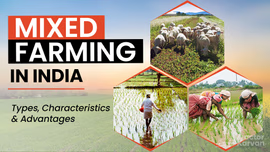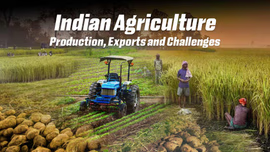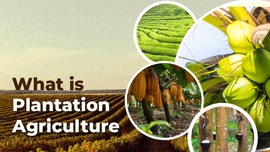AI in Indian Agriculture: Way towards Smart Farming

Artificial intelligence has huge potential for transforming Indian agriculture. It offers key solutions related to pest control, crop monitoring, and precision farming. AI makes farming more sustainable, profitable, and efficient for farmers. Additionally, it contributes to environmental protection and food security. Go through this article to learn more about the adoption of AI in Indian agriculture and key government initiatives and projects.
Table of Contents
- Introduction to Artificial Intelligence in Indian Agriculture
- How is Artificial Intelligence Revolutionizing Indian Agriculture?
- What are the Government Initiatives related to Artificial Intelligence?
- Success Stories & Projects
Introduction to Artificial Intelligence in Indian Agriculture
The global AI in agriculture market is estimated to reach $4.7 billion by 2028. Between 2020 and 2022, the Indian government offered funding of around Rs. 4179 crores to states for the introduction of new technologies like GIS, remote sensing, blockchain, drones, and artificial intelligence in agriculture. In the same period, the Indian Council of Agricultural Research (ICAR) was allocated funds amounting to more than Rs. 15,210 crores to develop new technologies and capacity building of farmers.
Artificial intelligence (AI) is empowering human labour in the modern world. Its use in agricultural areas has huge implications for boosting efficiency and productivity. AI can allow farmers to do more with less resources and effort. AI is transforming India's agricultural sector, with AI solutions growing at an estimated CAGR of 23.1%. They facilitate real-time data and automation to tackle issues like labour shortages and weather unpredictability. AI-led agricultural revolution demands private sector involvement and government initiatives in India.
How is Artificial Intelligence Revolutionizing Indian Agriculture?
Precision Farming
AI technologies can support precision farming to help farmers make informed decisions in relation to crop management. Data from sensors, drones, and satellite imagery is analyzed using AI-powered tools for the optimization of pest control, fertilization, and irrigation. Drone-assisted aerial surveillance uses advanced computer vision to provide real-time detection of a wide range of crop health issues. With the help of these drones, nutrients or pesticides can be applied precisely where needed, which not only lowers environmental impact but also minimizes waste. Intelligent data integration is possible using the Internet of Things (IoT), remote and proximity sensing, which further assists in detailed field analysis, field surveys, and crop monitoring.
Monitoring Crop Health
Yield loss is a major concern in India, which is mainly caused by crop diseases. As per research, neural networks can help in the detection of diseases such as apple scabs with an accuracy of 95%. Yellow rust can be detected in wheat crops using machine learning algorithms, due to which timely intervention becomes possible. The National Pest Surveillance System is an AI-based surveillance system that helps farmers manage losses due to climate change and ensures healthier harvests.
Weed Management
Weeds are a major threat to crop productivity. Manual weeding is a highly labour-intensive task that demands more time and effort. On the other hand, chemical herbicides are harmful to the environment. Taking the help of computer vision, AI-driven systems can differentiate between crops and weeds. It helps in the selective application of herbicides that prevent environmental damage and reduce operating costs.
Monitoring Livestock Health
Livestock management is integral to Indian agriculture. It can be easily streamlined by AI. Image recognition technologies and advanced sensor-based systems can be used for real-time monitoring of livestock behaviour and health. Using these systems, early signs of illnesses can be detected, which helps in taking protective measures to enhance livestock productivity.
What are the Government Initiatives related to Artificial Intelligence in Indian Agriculture?
The Indian government has taken up several initiatives to address different issues in the agricultural sector to help farmers.
- Kisan e-Mitra is an AI-powered chatbot that can be used by farmers to get information related to the PM Kisan Samman Nidhi scheme. It comes with support for multiple languages and integration with other government programs.
- Initiatives involving AI-based analytics for crop health assessment with the help of field photographs. Also, it uses crop health monitoring via soil, weather, and satellite data for wheat and rice.
- National Pest Surveillance System uses Machine Learning and AI for the detection of crop issues. It helps in managing produce loss and ensuring healthier crops.
Success Stories & Projects
MoU between Microsoft & Karnataka
In 2017, the Karnataka government signed an MoU with Microsoft Corporation India Pvt. Ltd. It aimed to provide technology-oriented solutions to empower smallholder farmers. Also, the goal is to offer artificial intelligence and other cutting-edge innovations to ensure higher crop yields and income for farmers. This collaboration also works with the Karnataka Agricultural Price Commission (KAPC) for improvements in price forecasting practices.
Sugarcane Farming- Baramati, Maharashtra
Sugarcane cultivation is practiced on a large scale in Maharashtra. So, AI has been used to increase the productivity of sugarcane farming through an experiment conducted by the Agricultural Development Trust of Baramati using Microsoft solutions like Azure Data Manager for Agriculture (ADMA). Oxford University, Microsoft, and the Trust joined hands to grow more crops with lower costs. This experiment started in March 2024 and involved around 1,000 farmers. It offered all the updates to farmers on their cell phones.
There is a weather station in the form of a tall metal structure with rain, humidity, temperature, solar, and wind gauges. There are sensors at the bottom to measure nutrients, electrical conductivity, pH, and moisture. The data obtained from the weather station is used along with historical data, satellite and drone imagery. A mobile application provides daily alerts, including water and fertilizer applications or scouting for pests. It also offers the exact location where intervention is required.
The result showcased a 30 to 40% increase in sugarcane production. In addition, 20 to 40% of production costs were reduced, while 30% water savings were observed. Following are some key findings about sugarcane production with AI:
- Average weight of sugarcane: 3-5 kg per cane
- Sugarcane plants in an acre: 4500 (5 x 1.5 feet)
- Sugarcane in an island: 8-10
- Weight of sugarcane per acre: 120 tons
- Sugarcane broken per acre: 42500-45000
Artificial intelligence is effective in agriculture to help improve efficiency and resource utilization. Also, it tackles the issues presented by labour shortages and resource scarcity. AI can play a big role in transforming Indian agriculture with data-driven decision-making and ensuring food security for the increasing population. Challenges like limited infrastructure, limited technological access, and knowledge need to be addressed to realize the full potential of AI for Indian farmers.


Related Blogs












